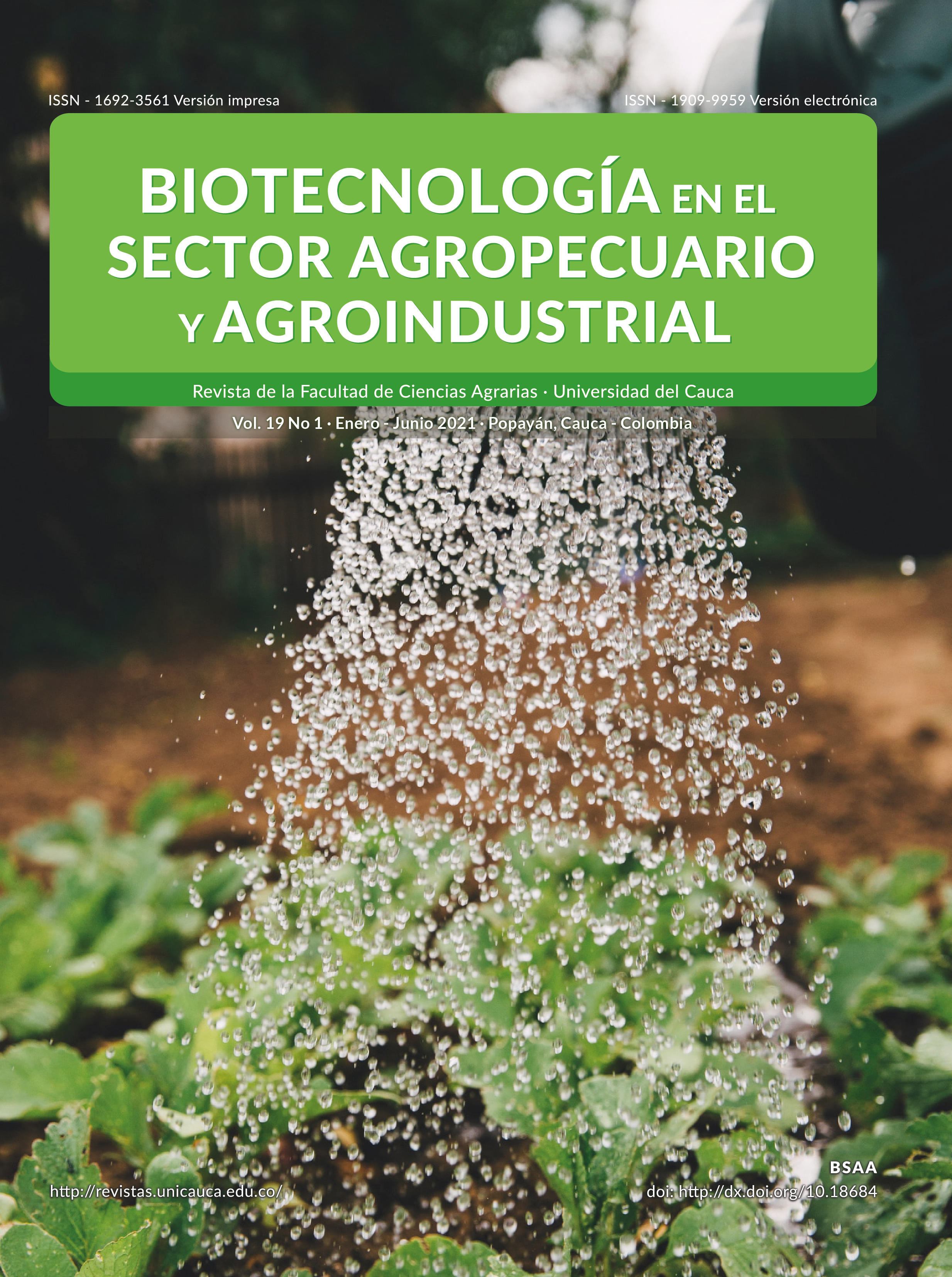Efecto de la humedad relativa en la capacidad encapsulante de los coproductos de la molienda humeda del grano de amaranto
Resumen
Los coproductos de la extracción del almidón de amaranto han despertado recientemente el interés de la industria, principalmente debido a sus características funcionales. En este trabajo se investigó la eficiencia de encapsulación de un harina (SEF) y el almidón nativo (NS) obtenidos mediante molienda abrasiva y húmeda, respectivamente. Se evaluaron los efectos de la humedad de almacenamiento (11 a 84%, por 21 días) sobre la retención del β-caroteno encapsulado y superficial. Se encontraron efectos significativos de la proteína de amaranto presente en la harina molida SEF-BM sobre la emulsificación y la posterior retención de β-caroteno. La matriz SEF-BM mostró el mejor rendimiento de encapsulación, con tres veces el contenido total de β-caroteno en comparación con las matrices que contenía NS. La temperatura de transición vítrea (Tg) de las muestras disminuyó con el aumento de la humedad relativa debido al efecto plastificante del agua, lo que provocó un aumento en su movilidad. El coproducto SEF mostró un alto potencial tecnológico como agente encapsulante y su proteínas nativas sirvieron como un buen estabilizador emulsionante.
Descargas
Disciplinas:
AgroindustriaLenguajes:
Español; CastellanoReferencias bibliográficas
NIETO-CALVACHE, JHON; CUETO, MARIO; FARRONI, ABEL; DE ESCALADA-PLA, MARINA; GERSCHENSON, LÍA-NOEMI. Antioxidant characterization of new dietary fiber concentrates from papaya pulp and peel (Carica papaya L). Journal of Functional Foods, v. 27, 2016, p. 319-328.
https://doi.org/10.1016/j.jff.2016.09.012
VARGAS-MURGA, LILIANA; DE ROSSO, VERIDIANA; MERCADANTE, ADRIANA; OLMEDILLA-ALONSO, BEGOÑA. Fruits and vegetables in the Brazilian Household Budget Survey (2008–2009): carotenoid content and assessment of individual carotenoid intake. Journal of Food Composition and Analysis, v. 50, 2016, p. 88-96. https://doi.org/10.1016/j.jfca.2016.05.012
MÜLLER, LARS; CARIS-VEYRAT, CATHERINE; LOWE, GORDON; BÖHM, VOLKER. Lycopene and its antioxidant role in the prevention of cardiovascular diseases a critical review. Critical Reviews in Food Science and Nutrition, v. 56, n. 11, 2016, p. 1868-1879. https://doi.org/10.1080/10408398.2013.801827
JANISZEWSKA-TURAK, EMILIA. Carotenoids microencapsulation by spray drying method and supercritical micronization. Food research international, v. 99, 2017, p. 891-901. https://doi.org/10.1016/j.foodres.2017.02.001
URSACHE, FLORENTINA-MIHAELA; ANDRONOIU, DOINA-GEORGETA; GHINEA, IOANA-OTILIA; BARBU, VASILICA; IONIŢĂ, ELENA; COTÂRLEŢ, MIHAELA; DUMITRASCU, LOREDANA; BOTEZ, ELISABETA; RĂPEANU, GABRIELA; STĂNCIUC, NICOLETA. Valorizations of carotenoids from sea buckthorn extract by microencapsulation and formulation of value-added food products. Journal of Food Engineering, v. 219, 2018, p. 16-24.
https://doi.org/10.1016/j.jfoodeng.2017.09.015
GÓMEZ, C.A.; CASTRO, J.; RANGEL, E.; NAVARRO, R.O.; CABRERA, Z.E.; DÍAZ, L.; MARTÍNEZ, F.; GUZMÁN, F.A.; FALFAN, R.N. A modified Achira (Canna indica L.) starch as a wall material for the encapsulation of Hibiscus sabdariffa extract using spray drying. Food Research International, v. 119, 2019, p. 547-553.
https://doi.org/10.1016/j.foodres.2018.10.031
ZHU, FAN. Encapsulation and delivery of food ingredients using starch-based systems. Food Chemistry, v. 229, 2017, p. 542–552.
https://doi.org/10.1016/j.foodchem.2017.02.101
AGUIAR, J.; ESTEVINHO, B.N.; SANTOS, L. Microencapsulation of natural antioxidants for food application - The specific case of coffee antioxidants. A review. Trends in Food Science and Technology, v. 58, 2016, p. 21-39.
https://doi.org/10.1016/j.tifs.2016.10.012
XU, YAFENG; WANG, CHAN; FU, XIONG; HUANG, QIANG; ZHANG, BIN. Effect of pH and ionic strength on the emulsifying properties of two Octenylsuccinate starches in comparison with gum Arabic. Food Hydrocolloids, v. 76, 2018, p. 96-102. https://doi.org/10.1016/j.foodhyd.2017.02.015
TALÓN, EMMA; VARGAS, MARÍA; CHIRALT, AMPARO; GONZÁLEZ-MARTINEZ, CHELO. Eugenol incorporation into thermoprocessed starch films using different encapsulating materials. Food Packaging and Shelf Life, v. 21, 2019, p. 100326. https://doi.org/10.1016/j.fpsl.2019.100326
JIN, YANGYANG; LI, JASON; NIK, AMIR-MALAKI. Starch-based microencapsulation. Starch in Food, 2018, p. 661-690.
https://doi.org/10.1016/B978-0-08-100868-3.00017-2
ROA, DIEGO; BUERA, PILAR; TOLABA, MARCELA; SANTAGAPITA, PATRICIO. Encapsulation and stabilization of β- carotene in amaranth matrices obtained by dry and wet assisted ball milling. Food and Bioprocess Technology, v. 10, 2017, p. 512-521.
https://doi.org/10.1007/s11947-016-1830-y
HOYOS-LEYVA, JAVIER D., BELLO-PÉREZ, LUIS A.; ALVAREZ-RAMIREZ, J.; GARCIA, HUGO S. Microencapsulation using starch as wall material: A review. Food reviews international, v. 34, n. 2, 2018, p. 148-161.
https://doi.org/10.1080/87559129.2016.1261298
DE BARROS-FERNANDES, REGIANE-VICTÓRIA; COSTA-GUIMARÃES, ISABELA; RODRIGUES-FERREIRA, CHRISTIANE-LARA; ALVARENGA-BOTREL, DIEGO; VILELA-BORGES, SORAIA; DE SOUZA, AMANDA-UMBELINA. Microencapsulated Rosemary (Rosmarinus officinalis) essential oil as a biopreservative in minas frescal cheese. Journal of Food Processing and Preservation, v. 41, n. 1, 2019, p. 12759. https://doi.org/10.1111/jfpp.12759
GORDON, MANFRED; TAYLOR, JAMES S. Ideal copolymers and the 2nd order transitions of synthetic rubbers. Non-crystalline copolymers. Journal of Applied Chemistry, v. 2, n. 2, 1952, p. 493-500.
https://doi.org/10.1002/jctb.5010020901
LABUZA, T.P.; NALLY, L.; GALLAGHER, D.; HAWKES, J.; HURTADO, F. Stability of intermediate moisture foods. Lipid oxidation. Journal of Food Science, v. 37, n. 1, 1972, p. 154-159.
https://doi.org/10.1111/j.1365-2621.1972.tb03408.x
GOLMAN, M.; HOREV, B.; SAM-SAGUY, I. Decolorization of β-Carotene in Model Systems Simulating Dehydrated Foods. Mechanism and Kinetic Principles, 1983, p. 52.
https://doi.org/10.1111/j.1365-2621.1983.tb14890.x
VAN DEN BERG, C.; BRUIN, S. Water activity and its estimation in food systems: Theoretical aspects. In: Water Activity: Influence on Food Quality. L. Rockland and G. Stewart. New York (USA): Academic Press, 1981, p. 1-61.
FURMANIAK, SYLWESTER; TERZYK, ARTUR P.; GOLEMBIEWSKI, ROMAN; GAUDEN, PIOTR A.; CZEPIRSKI, LESZEK. Searching the most optimal model of water sorption on foodstuffs in thewhole range of relative humidity. Food Research International, v. 42, n. 8, 2009, p. 1203-1214.
https://doi.org/10.1016/j.foodres.2009.06.004
SPERLING, L.H. Introduction to Physical Polymer Science. New York (USA): John Wiley & Sons, 1986, p.46-48
JOUPPILA, K.; ROOS, Y. The physical state of amorphous corn starch and its impact on crystallization. Carbohydrate Polymers, v. 32, n. 2, 1997, p. 95.
https://doi.org/10.1016/S0144-8617(96)00175-0
ZHONG, ZHIKAI; SUN, SUSAN. Thermal characterization and phase behavior of cornstarch studied by differential scanning calorimetry. Journal of Food Engineering, v. 69, n. 4, 2005, p. 453-459.
https://doi.org/10.1016/j.jfoodeng.2004.07.023
KATKOV, IGOR I.; LEVINE, FRED. Prediction of the glass transition temperature of water solutions: comparison of different models. Cryobiology, v. 49, n. 1, 2004, p. 62-67. https://doi.org/10.1016/j.cryobiol.2004.05.004
FONSECA-FLORIDO, HEIDI A.; GÓMEZ-ALDAPA, CARLOS A.; VELAZQUEZ, GONZALO; HERNÁNDEZ-HERNÁNDEZ, ERNESTO; MATA-PADILLA, JOSÉ M.; SOLÍS-ROSALES, SILVIA G.; MÉNDEZ-MONTEALVO, GUADALUPE. Gelling of amaranth and achira starch blends in excess and limited water. LWT-Food Science and Technology, v. 81, 2017, p. 265–273.
https://doi.org/10.1016/j.lwt.2017.03.061
OCHOA-VELASCO, C.E.; SALAZAR-GONZÁLEZ, C.; CID-ORTEGA, S.; GUERRERO-BELTRÁN, J.A. Antioxidant characteristics of extracts of Hibiscus sabdariffa calyces encapsulated with mesquite gum. Journal of Food Science and Technology, v. 54, n. 7, 2017, p. 1747–1756.


 Español
Español Inglés
Inglés





















.png)



